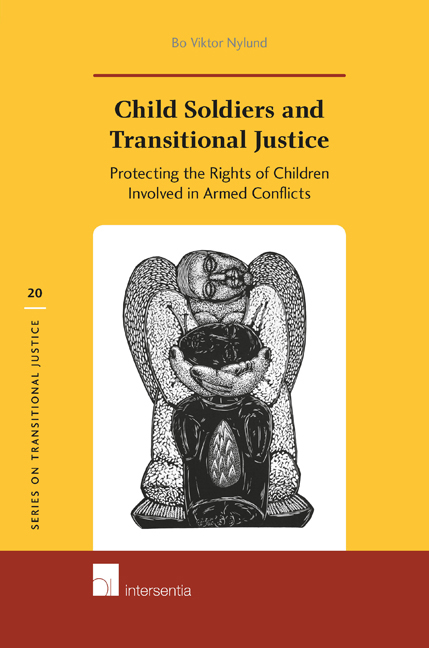 Child Soldiers and Transitional Justice
Child Soldiers and Transitional Justice Book contents
- Frontmatter
- Acknowledgements
- About the Author
- Contents
- List of Abbreviations
- Chapter 1 Objective, Scope, and Transitional Justice as an Analytical Framework
- Chapter 2 Child Recruitment and the Rule of Law: International Law and the Prohibition against Recruiting and Using Children to Take Direct Part in Hostilities
- Chapter 3 Child Recruitment and Criminal Justice: the Lubanga Case
- Chapter 4 Child Recruitment and Historical Justice: the Security Council Mechanism on Monitoring and Reporting
- Chapter 5 Child Recruitment and Reparatory Justice: Recovery and Reintegration of War-Affected Children
- Chapter 6 Child Recruitment and Institutional Justice
- Chapter 7 Children Involved in Armed Conflict and Participatory Justice: Balancing Rights and Responsibilities
- Chapter 8 Conclusions: Transitional Justice and the Potential for Stronger Protection of the Rights of Children Involved in Armed Conflicts
- Annexes
- Bibliography
Chapter 4 - Child Recruitment and Historical Justice: the Security Council Mechanism on Monitoring and Reporting
Published online by Cambridge University Press: 12 December 2017
- Frontmatter
- Acknowledgements
- About the Author
- Contents
- List of Abbreviations
- Chapter 1 Objective, Scope, and Transitional Justice as an Analytical Framework
- Chapter 2 Child Recruitment and the Rule of Law: International Law and the Prohibition against Recruiting and Using Children to Take Direct Part in Hostilities
- Chapter 3 Child Recruitment and Criminal Justice: the Lubanga Case
- Chapter 4 Child Recruitment and Historical Justice: the Security Council Mechanism on Monitoring and Reporting
- Chapter 5 Child Recruitment and Reparatory Justice: Recovery and Reintegration of War-Affected Children
- Chapter 6 Child Recruitment and Institutional Justice
- Chapter 7 Children Involved in Armed Conflict and Participatory Justice: Balancing Rights and Responsibilities
- Chapter 8 Conclusions: Transitional Justice and the Potential for Stronger Protection of the Rights of Children Involved in Armed Conflicts
- Annexes
- Bibliography
Summary
“Could you please write a letter to Mr. Tamil Selvan [head of political wing in the LTTE] to tell him that he had made a mistake. He says all the children have come home, but he has forgotten my child. Please tell him to find my child and send her home.”
INTRODUCTION
Historical justice is about establishing the facts of what has occurred in the past in order to promote the most effective application of justice in the present. This element of transitional justice is oft en understood to relate to truth commissions, but it draws on several other activities, including those of the criminal justice processes for establishing the facts, distinct fact-finding exercises, and human rights investigations of diverse kinds.
Chapter 4 primarily considers the outcome of the Security Council thematic focus on children and armed conflict as a contribution to historical justice. At the time of the establishment of the monitoring and reporting mechanism of the Security Council in resolution 1612 (2005), it was emphasized that the mechanism was established in order “to collect and provide timely, objective, accurate and reliable information on the recruitment and use of child soldiers in violation of applicable international law and on other violations and abuses committed against children affected by armed conflict.” This chapter offers an analysis of the value added by the information gathered through the mechanism and the subsequent conclusions made by the Security Council Working Group (SCWG) on children and armed conflict, as well as action plans developed with armed groups and forces for the release and reintegration of children within the international legal framework for the protection of children during armed conflicts. While the mechanism does much more than gather information, its ultimate purpose is to pave the way for informed action and political transformation in a context of transitional justice.
While there are many options for how to establish the facts, the way that the facts are established and who is behind the fact finding make a great difference.
- Type
- Chapter
- Information
- Child Soldiers and Transitional JusticeProtecting the Rights of Children Involved in Armed Conflicts, pp. 109 - 134Publisher: IntersentiaPrint publication year: 2016


